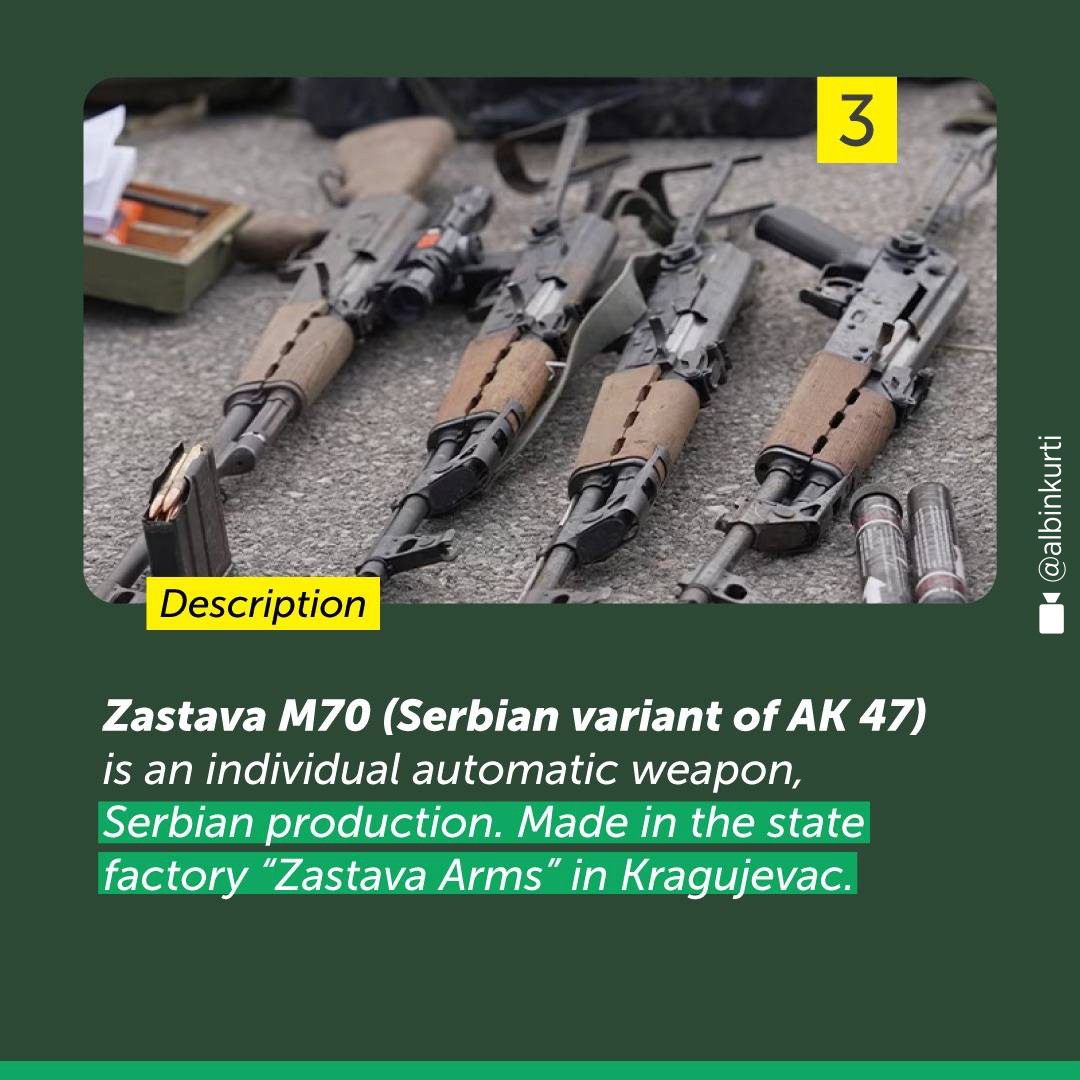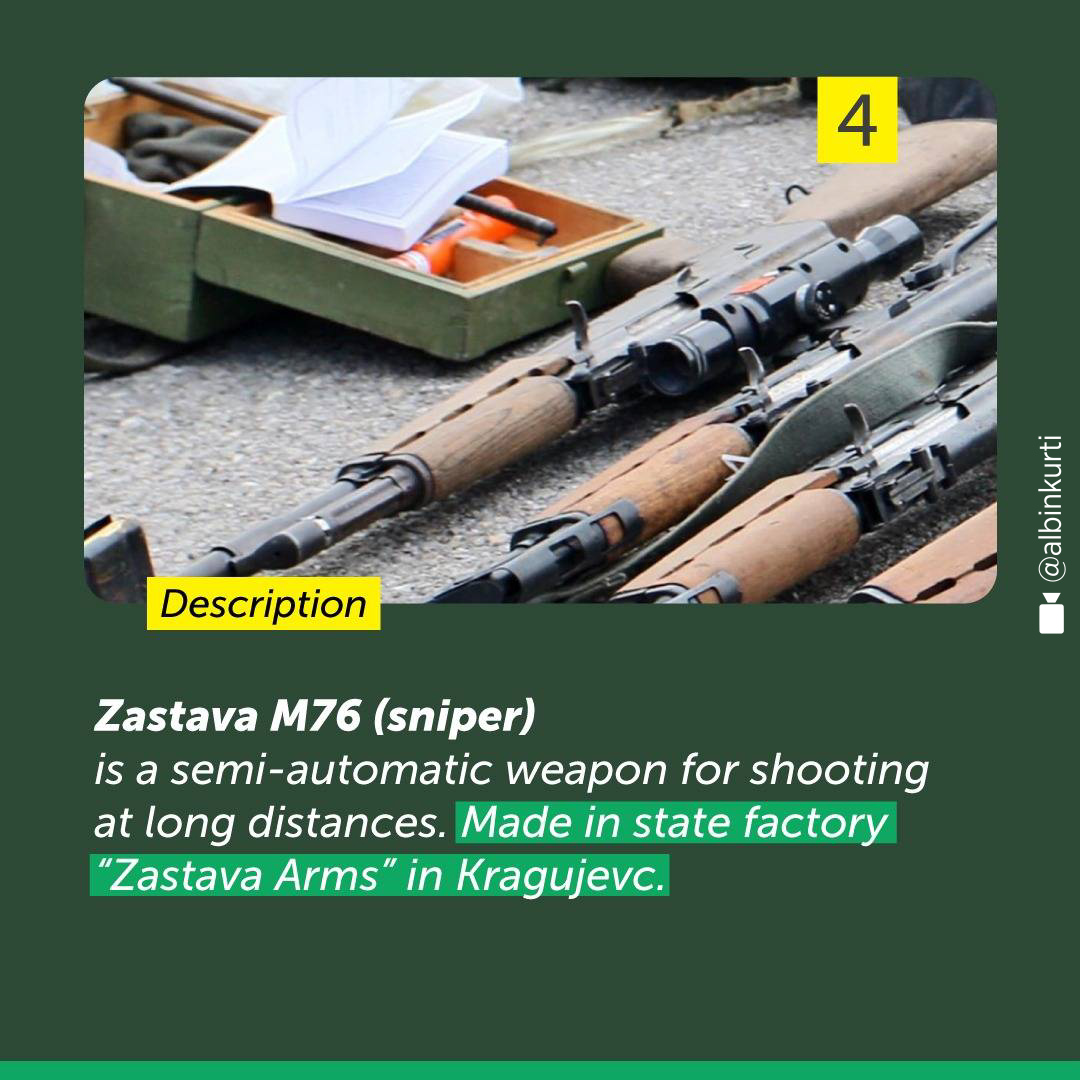Nearly all weapons seized by Kosovo after weekend clash were produced in Serbia for 1999 crisis: Analyst
Structure of weapons indicates there is an active paramilitary unit in Kosovo, says Serbian military analyst Aleksandar Radic
 Heavy weapons, vehicles and ammunition are displayed, which were seized after the day-long clashes with the armed Serb group in Banjska, Kosovo on September 25, 2023. ( Erkin Keci - Anadolu Agency )
Heavy weapons, vehicles and ammunition are displayed, which were seized after the day-long clashes with the armed Serb group in Banjska, Kosovo on September 25, 2023. ( Erkin Keci - Anadolu Agency )
BELGRADE, Serbia
The weapons seized by police in northern Kosovo following a deadly shootout Sunday between police and gunmen were made in Serbia and date back to the 1999 crisis in the region, Aleksandar Radic, a Serbian military analyst from Belgrade, told Anadolu.
Residents in the region woke up that day to the news that a clash between an armed group and police had broken out in the village of Banjska near the Serbian border.
Kosovo's Interior Minister Xhelal Svecla said Wednesday that evidence is mounting that Serbia was involved in “terrorist action” in his country as he posted photos of a document and arms that were seized from the Serbian armed group after the clash, which left one police officer dead and another wounded.
"The weapons and other equipment used in this week's terrorist attacks were made by Serbian state-owned military arms producers. The idea that 26 military SUVs and a vast Serbian state-produced arsenal entered Kosovo all without the Serbian government’s involvement is simply not credible," Kosovo Prime Minister Albin Kurti said Thursday.

"Almost all examples of weapons from Banjska were produced in Serbia, but that says nothing about the users of the weapons. Most of the automatic rifles may have been in Kosovo since 1999, when conscripts were mobilized and local territorial defense units were formed. Their personal weapons remained in considerable quantities in the hands of people who remained to live in Kosovo after the withdrawal of the Yugoslav Army and the Serbian police in June 1999. No one confiscated their weapons at the time because the political position was to provide a means for self-defense," said Radic.
"The problem is some means of support -- automatic grenade launchers and mortars -- because it can be seen that they are newer, and therefore the important question now is how and when they came into the hands of the paramilitary formation.”

Clashes broke out in Banjska when a group of armed Serbs blocked a bridge. A shootout erupted when the group opened fire on police.
Kurti also claimed that the armed Serbian group was led by Milan Radojcic, a Kosovo Serb politician and one of the leaders of the Serb List party, the main political party representing Serbs in Kosovo.
Serbian President Aleksandar Vucic and Foreign Minister Ivica Dacic on Wednesday denied allegations of Belgrade's role in the deadly weekend clash in Kosovo.
According to Radic, the structure of the weapons indicates that there is an active paramilitary unit in Kosovo.
"The information we have seen so far indicates there is an active paramilitary unit that has infantry weapons and means of fire support. According to the structure of the weapons, the unit is the equivalent of a troop, because in addition to automatic rifles and mortars, in the spoils of the Kosovo police there are 82mm caliber mortars, 30mm automatic grenade launchers and 12.7mm anti-materiel rifles. These are means of support at the troop level," he said.

Answering a question about claims that the group was hiding the weapons in a 14th-century Orthodox monastery located in Banjska, Radic said the group used the monastery only as a cover during the clashes.
"The paramilitary unit had weapons and other resources in vehicles, armored trucks and a few dozen off-road vehicles. Then they broke down the entrance door to the monastery when they were looking for cover by crashing their vehicle into the fence. I conclude that the place of events around the monastery was a coincidence, not an intention," he said.
The clash took place around the monastery.
Radic said the future of the region depends on politicians, not weapons.
"Politicians start conflicts, and weapons are just tools. That is why the future of the region depends on the political moves of the authorities in Belgrade and Pristina, and on both sides, there are military and security formations formed by law, as well as paramilitary ones such as the unit that was destroyed in Banjska," he said.
He said that what happened on the weekend was the paramilitary unit being caught in non-combat activity by coincidence, if someone did not have a political motive.
"It is certain that the paramilitary unit was not involved in any specific action, and that is why I believe that, based on all the information presented so far, it is not true that they were conducting any specific activity against Kosovo, as claimed by officials in Pristina and that Belgrade's claim that it is a Serb rebellion against the organized actions of the Pristina authorities is not correct," said Radic.

“I believe that the unit was caught in some non-combat activity, because the conflict occurred when the Kosovo border police, unaware of the risk, entered into the first combat contact when one police officer was killed and one was wounded. An open topic is whether someone reported that something was happening in Banjska, because if it happened, then those persons had political motives. That is, they wanted the incident to happen.”
A group of armed Serbs blocked a bridge leading to Banjska with two trucks that did not have license plates.
A shootout erupted after the group opened fire on police, who went to the scene to investigate.
A large number of security forces were dispatched to the region, and the Brnjak border crossing between Kosovo and Serbia was closed.
The area has been the scene of unrest since April, when local ethnic Serbs boycotted elections in northern Kosovo, followed by protests against the election of ethnic Albanian mayors.
Albanians are by far the largest ethnic group in Kosovo, followed by Serbs, with about half living in the north.
Amid the unrest concerning the elections, NATO peacekeepers were deployed, including a group of extra Turkish reinforcements.
Kosovo declared independence from Serbia in 2008 and gained recognition from many countries, including Türkiye. But Belgrade has never recognized Kosovo and claims it is still part of Serbia.
Anadolu Agency website contains only a portion of the news stories offered to subscribers in the AA News Broadcasting System (HAS), and in summarized form. Please contact us for subscription options.







